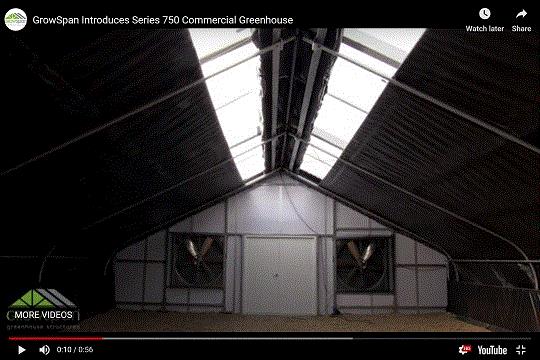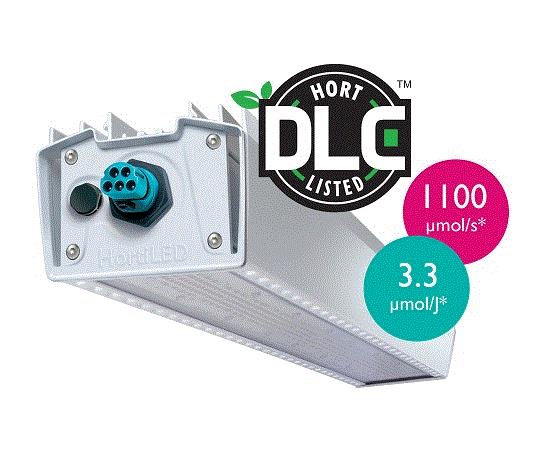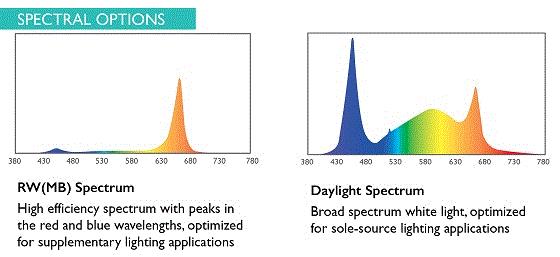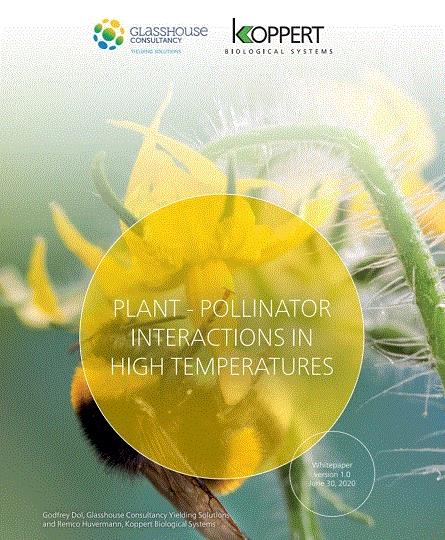It's a Cannabis Thing
GrowSpan Greenhouse Structures just released a new type of greenhouse that features an internal light deprivation system. Coming from the ornamental side, my first thought was why would anyone do that? My second thought is it must be a cannabis thing. It is, indeed, a cannabis thing.
The Series 750 Commercial Greenhouse has a unique, cost-effective design in a cable-driven system in the internal substructure that allows the grower to roll up blackout curtains within moments to allow for darkness in the greenhouse. The s750s come in 32-ft. widths and can be built in 48-ft., 72-ft., 96-ft. and 120-ft. lengths, according to GrowSpan. The greenhouses can be made, upon request, to withstand 105-mph winds, 25 psf snow loads and 12 psf live loads.

Click the image to see how the greenhouse works.
I went down the rabbit hole of cannabis lighting to better understand why this technology would be coveted in the cannabis world. Hort Americas has a quick primer on lighting impacts on hemp and cannabis.

ICYMI: CFAP Expands Commodities for Funding
This newsletter (hopefully) entertains and informs readers from across multiple aspects of the CEA industry, some of whom also have nursery crops. So I wanted to include these details from my colleague Jen Zurko about the expanded CFAP funding:
U.S. Secretary of Agriculture Sonny Perdue announced in August that additional commodities—which now includes horticulture and nursery products—are covered by the Coronavirus Food Assistance Program (CFAP) in response to over 1,700 public comments and data. Additionally, the U.S. Department of Agriculture (USDA) is extending the deadline to apply for the program to September 11 and producers with approved applications will receive their final payment.
AmericanHort and other industry organizations have been working diligently on getting horticulture included in the program and their efforts have paid off.
Craig Regelbrugge, Vice President of Advocacy and Government Relations for AmericanHort, said in a statement: “AmericanHort extends our sincere appreciation to the USDA for working with us to provide meaningful nursery and floriculture grower relief. For countless horticultural producers, the effects of the coronavirus’ sudden closure of markets during our peak selling season risked destroying businesses across the supply chain. We are happy to report Secretary Sonny Perdue and Under Secretary Bill Northey responded with understanding to help the industry successfully navigate the pandemic by expanding eligibility to this program.”
The program—funded through the Coronavirus Aid, Relief, and Economic Stability (CARES) Act and the Commodity Credit Corporation—provides direct assistance payments to eligible commodities for which significant losses occurred due to pandemic-related market disruption.
USDA collected comments and supporting data for consideration of additional commodities through June 22, 2020. Nursery crops and flowers are eligible for CFAP, which includes everything potted in floriculture, grown in a greenhouse or outside, plus cut flowers and cut greens. Relief payments may cover two types of losses:
-
For nursery crop and cut flower inventory that was shipped, but subsequently spoiled or is unpaid due to loss of marketing channels between January 15, 2020 and April 15, 2020, the wholesale value of the inventory that was shipped that spoiled or is unpaid, multiplied by 15.55%; and,
-
For nursery crop and cut flower inventory that did not leave the farm between January 15, 2020 and April 15, 2020 due to a complete loss of marketing channel, the wholesale value of the inventory ready for sale that did not leave the farm by April 15, 2020, and that will not be sold due to lack of markets, multiplied by 13.45%.
Nursery crop and cut flower inventory that may be sold after April 15, 2020 is not eligible for CFAP. Note also that there are overall payment limits and entities deriving income from non-agricultural sources may have other eligibility limits.
To ensure availability of funding, producers with approved applications initially received 80% of their payments. The Farm Service Agency (FSA) will automatically issue the remaining 20% of the calculated payment to eligible producers. Going forward, producers who apply for CFAP will receive 100% of their total payment, not to exceed the payment limit, when their applications are approved.

Producers, especially those who haven’t worked with FSA previously, are recommended to call (877) 508-8364 to begin the application process. An FSA staff member can help producers start their application during the phone call. Additional details can be found at farmers.gov/cfap.

New LEDs from P.L. Light Systems
LEDs are all about reducing energy costs while providing optimal lighting for crops and P.L. Light Systems has introduced a new light it says addresses both.
The HortiLED Top 2.0 is designed to reduce energy consumption by as much as 40% versus traditional HPS, according to the company, as well as offer two spectrums designed for optimal spectral efficiencies in both supplementary and sole source applications. They can be used as all LED or in a hybrid mix with HID luminaires.

“The HortiLED Top 2.0 is thermally and mechanically engineered to dissipate heat through conduction and convection paths—minimizing LED junction temperature and maximizing light output, lifetime and reliability,” the company says in a release. “The product’s sleek design features an integrated driver—reducing the amount of equipment to be installed and further minimizing shadowing in greenhouse applications, so plants will receive the maximum amount of light.”

CLICK HERE to learn more about the lights.

Pollinators & High Temperatures
Every tomato, cucumber and strawberry greenhouse I’ve ever been in has used bees in the greenhouse for pollination. There appears to be a lot more to the process, though, than just opening a box of bumblebees and letting them have at it.
Koppert Biological Systems recently released a white paper on the impacts of high temperatures on the pollination process. Here’s a quick excerpt from the white paper talking about tomato pollination:
“Poorly pollinated flowers never become premium fruit, no matter how perfect a climate the grower creates. Pollination therefore deserves the utmost attention. Many aspects need to be considered for good pollination. Pollinating insects, the strength of plants and environmental conditions all play an important role. It is crucial to recognize the direct and longer-term impact of hot climate conditions affecting both the plants/flowers and pollinating insects such as bumblebees.”

CLICK HERE to take the deep dive into the intertwined relationship between temperature and pollination. Downloading the free white paper requires an email address.

Mucci Farms Drops a Pod
Podcasts are a great way to talk directly to your audience, no matter who they are. The folks at Mucci Farms realize this, and after months of discussion (according to the introductory pod by Public Relations and Digital Marketing Manager Ajit Saxena), they pulled the trigger on a new pod called Spill the Greens. On the pod, listeners will get the inside scoop about what CEA growing is about from Ajit, who will host, and the guests who appear.
“We want to use this podcast to increase our transparency and address any assumptions and questions you might have,” Ajit says in the introductory podcast. “Over the years we’ve been finding that every generation seems to care a little more about where their food comes from. But it seems that today’s generation is turning over really, really fast. They care so much about where everything comes from and they demand that transparency from us. And as people that work with fruits and vegetables that’s very, very exciting for us—we always want people to care where their food comes from.”

The first two, the introductory one from Ajit and Episode 1 featuring CEO Bert Mucci, are available now wherever you listen to podcasts (I personally use CastBox if you need a free player recommendation).




As always, feel free to email me at jpolanz@ballpublishing.com with comments, questions, news and views.
Until next time, stay safe and be healthy,

Jennifer Polanz
Editor-at-Large
Inside Grower
This email received by 24,786 loyal readers!
Interested in advertising in Inside Grower? Contact Paul Black or Kim Brown and they'll show you how easy, effective and affordable it is.